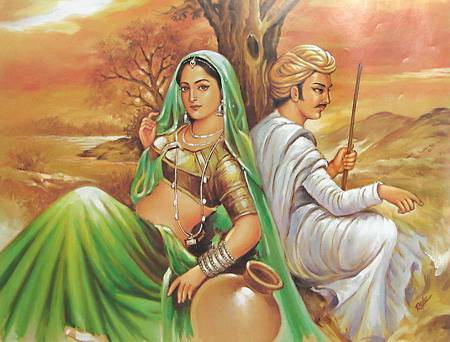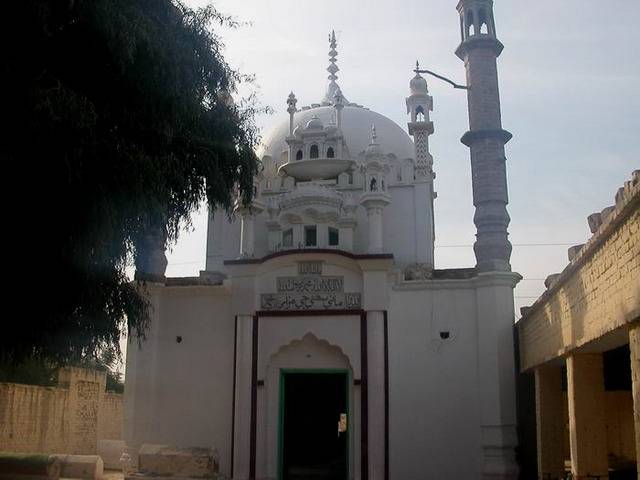Prof. Dr. Shaukat Mahmood
It’s dark and the river is in flood
There is water all around me
How am I going to meet Mahiwal?
If I keep going, I will surely drown
And if I turn back
I would be going back on my promise
And letting Mahiwal down
I beg you (O pitcher!), with folded hands,
Help me meet my Mahiwal
You always did it, please do it tonight, too.
Sohni Mehar or Sohni Mahiwal is a tragic love story associated with river Chenab and the city of Gujrat. She was daughter of a potter Tullha. At the time, Gujrat, on the river Chenab, was a caravanserai on the trade route between Bukhara and Delhi. “As Sohni grew up, she helped her father decorate his pots. Their shop is said to have been near Rampyari Mahal by the river.As soon as the surahis (goglets) and mugs came off the wheel, she would draw artistic designs on them and set them up for sale.”It is believed that the heroine Sohni was forced to marry a man whom she never liked, when her love affair came to the knowledge of her parents. She swam every night across the river to meet Mehar (Mahiwal). One wonders why Meher did not swim to the river side of Sohni. One night her sister-in-law replaces the kiln-burnt earthenware pot (pitcher), which she used to keep her afloat in water, with a vessel of unbaked clay, which dissolved in water and she drowned in the treacherously whirling waves of the river. Most probably learning the fate of Sohni Mahiwal also ended his life by jumping into the river. “Legend has it that the bodies of Sohni and Mahiwal were recovered from the River River Indus near Shahdadpur, Sindh some 75 km far from Hyderabad. Sohni's tomb is located at Shahpur Chakar Road, Shahdadpur.” Tomb of Sohni is also located there.
Sohni is one of the most popular favourite folktales both in Sindh and Punjab along with Heer Sayal and Sassi Panhun (Pannu).
The story also appears in Shah Jo Risalo a poetic compendium of famous Sindhi Sufi poet Shah Abdul Latif Bhittai and forms part of seven popular tragic romances from Sindh. The other six tales areUmar Marvi, Sassui Punhun, Lilan Chanesar, Noori Jam Tamachi, Sorath Rai Diyach and Momal Rano commonly known as Seven heroines (Satt Surmiyun in Sindhi).
“Mahiwal was not a local. He was a rich trader from Bukhara (Uzbekistan), his real name was Shahzada Izzat Baig he came to Punjab on a business trip and halted in the town of Gujrat. Here he saw Sohni at the shop and was completely smitten. Instead of looking after the mohars (gold coins) and his business he visited the shop of Sohni daily to get a glimpse of her, he would end up buying the water pitchers, bowls and mugs every day.”
“Instead of returning to Bukhara with his caravan, the noble-born Izzat Baig took up the job of a servant in the house of Tulla. He would even take their buffaloes for grazing. Soon, he came to be known as Mehar or "Mahiwal" (buffalo herder). The question remains if he became a servant of Tulla then why was he on the other side of the river? Folk historian and concocters of myths offer no justification to this fact.
The Sohni Mahiwal love story continues to inspire numerous singers in modern day Pakistan, including Pathanay Khan's famous song Sohni Gharay nu akhadi aj mainu yaar milaa ghareya ( Sohni is imploring her pitcher that he, the pitcher, should help her in bringing about a union between her and Mahiwal). Pakistani and Indian film industries have produced several movies on the subject. In 1933 a film Sohni Mahiwal was produced that starred Gauhar Karnataki, Master Chonkar, Shivrani and Master Kanti. In 1946’s version the lead roles were played by Ishwar Lal and Begum Para. In 1958’s production of Sohni Mahiwal Nimmi and Bharat Bhushan played the title roles. Final version on the subject was screened in 1984 starring Sunny Deol and Poonam Dhillon. A Pakistan version produced in 1955 showed Sabiha and Sudhir in the lead roles.
Very few people know that there is a tomb in Gujrat known as the tomb of Emperor Jahangir, the fourth Mughal emperor. The royal Mughal family traveled to Kashmir from Agra almost every summer to escape the hot weather. The route adopted for this journey used to be through Sonipat, Jallandhar, Lahore, Gujranwala, Wazirabad, Gujrat, Bhimbar and Rajauri. Nurjahan, Jahangir’s wife had built several caravansara’is on this route. One such sara’i is at Chiryawla near Bhimbar. The history tells us that during his last journey, while going to Kashmir Jahangir died at Saadabad near Rajauri. According to his wish he was to be buried in Nurjahan’s garden at Shahdara near Lahore. As amanat he was buried in Rajauri while his entrails were buried in Gujrat hence the so called tomb of Jahangir in Gujrat. An annual festival Jahangir da Mela is regularly held at Gujrat to commemorate the occasion. Another side of the story is that the entrails of Jahangir were buried in Chingus Fort, Kashmir.
Famous Chinese traveler and scholar Huen Tsang (actual name Xuanzang) has referred about Bhimber in his travelogues. Xuanzang (602–664) was a Chinese Buddhist monk, scholar, traveler, and translator who described the interaction between China and India in the early Tang Dynasty. For centuries, Bhimber has remained as capital city of Chibhal. Raja Chib Chand who was the first Chib came to Bhimber about 1400 years ago. In Chibs, the first who embraced Islam was Sirsadi who is famous as Hazrat Baba Shadi Shaheed. He died during the reign of King Aurangzeb Alamgir. The last ruler of Chibhals was Raja Sultan Khan (1800–1840). Bhimber has been important strategically. It lies on the route that was followed by the Mughal Emperors for their frequent visits to the Kashmir Valley. It is also known as Bab-i Kashmir (Door to Kashmir) because of its importance and geographical location which was ideal for Mughal Emperors to enter Kashmir. Therefore, the Mughals used Bhimber as a staging point for journey to Srinagar. Mughal Emperor Jahangir has also discussed Bhimber in his book Tuzk-i Jahangiri.







